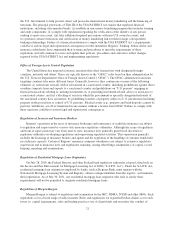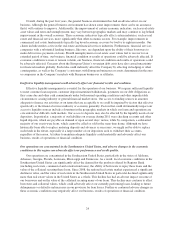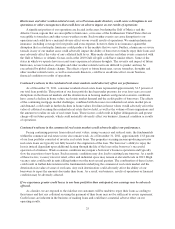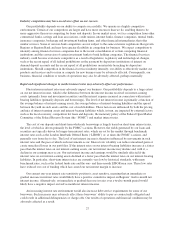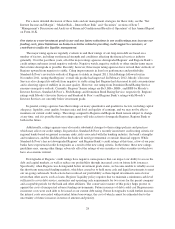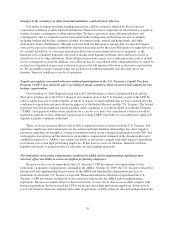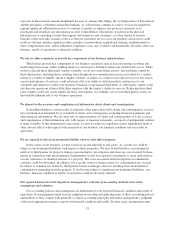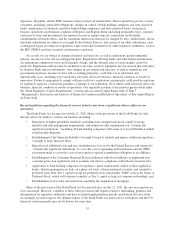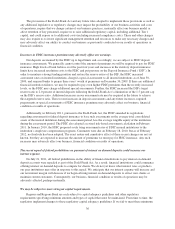Regions Bank 2011 Annual Report Download - page 50
Download and view the complete annual report
Please find page 50 of the 2011 Regions Bank annual report below. You can navigate through the pages in the report by either clicking on the pages listed below, or by using the keyword search tool below to find specific information within the annual report.We make various assumptions and judgments about the collectability of our loan portfolio and provide an
allowance for estimated credit losses based on a number of factors. Our management periodically determines the
allowance for loan losses based on available information, including the quality of the loan portfolio, economic
conditions, the value of the underlying collateral and the level of non-accrual loans. Increases in this allowance
will result in an expense for the period reducing our reported net income. If, as a result of general economic
conditions, a decrease in asset quality or growth in the loan portfolio, our management determines that additional
increases in the allowance for loan losses are necessary, we may incur additional expenses which will reduce our
net income, and our business, results of operations or financial condition may be materially and adversely
affected.
Although our management will establish an allowance for loan losses it believes is appropriate to absorb
probable and reasonable estimable losses in our loan portfolio, this allowance may not be adequate. In particular,
if a hurricane or other natural disaster were to occur in one of our principal markets of if economic conditions in
those markets were to deteriorate unexpectedly, additional loan losses not incorporated in the existing allowance
for loan losses may occur. Losses in excess of the existing allowance for loan losses will reduce our net income
and could adversely affect our business, results of operations or financial condition, perhaps materially.
In addition, bank regulatory agencies will periodically review our allowance for loan losses and the value
attributed to non-accrual loans or to real estate acquired through foreclosure. Such regulatory agencies may
require us to adjust our determination of the value for these items. These adjustments could adversely affect our
business, results of operations or financial condition.
Risks associated with home equity products where we are in a second lien position could adversely affect our
performance.
Home equity products, particularly those where we are in a second lien position, and particularly those in
certain geographic areas, may carry a higher risk of non-collection than other loans. Home equity lending
includes both home equity loans and lines of credit. Of the $13.0 billion home equity portfolio at December 31,
2011, approximately $11.6 billion were home equity lines of credit and $1.4 billion were closed-end home equity
loans (primarily originated as amortizing loans). This type of lending, which is secured by a first or second
mortgage on the borrower’s residence, allows customers to borrow against the equity in their home. Real estate
market values at the time of origination directly affect the amount of credit extended, and, in addition, past and
future changes in these values impact the depth of potential losses. Second lien position lending carries higher
credit risk because any decrease in real estate pricing may result in the value of the collateral being insufficient to
cover the second lien after the first lien position has been satisfied. We have realized higher levels of charge-offs
on second lien positions in the state of Florida, where real estate valuations have been depressed over the past
several years. As of December 31, 2011, approximately $7.1 billion of our home equity lines and loans were in a
second lien position (approximately $2.8 billion in Florida).
We are unable to track payment status on first liens held by another institution, including payment status
related to loan modifications. When our second lien position becomes delinquent, an attempt is made to contact
the first lien holder and inquire as to the payment status of the first lien. However, we do not and cannot
continuously monitor the payment status of the first lien position. When the first lien is held by a third party, we
can obtain an indication that a first lien is in default through information reported to credit bureaus. However,
because borrowers may have more than one mortgage reported on the credit report and there is not a
corresponding property address associated with reported mortgages, we are unable to associate a specific first
lien with our junior lien. The only communication we receive directly from the first lien holder for our junior lien
is notification at the time of foreclosure sale.
As of December 31, 2011, none of our home equity lines of credit have converted to mandatory
amortization under the contractual terms. The vast majority of home equity lines of credit will convert to
amortizing status after fiscal year 2020.
26







